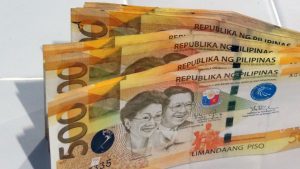THE NATIONAL GOVERNMENT’S (NG) gross borrowings spiked in September as its dollar bond issuance drove up foreign debt, the Bureau of the Treasury (BTr) said.
Data from the BTr showed that total gross borrowings soared by 255.64% to P367.18 billion in September from P103.25 billion in the same month a year ago.
Month on month, gross borrowings more than doubled from P174.03 billion in August.
The bulk or 60% of September’s gross borrowings came from external sources.
Gross external debt surged to P221.98 billion in September from P11.18 billion last year.
External borrowings in September included P140.99 billion in global bonds, P72.65 billion in program loans, and P8.35 billion in new project loans.
On the other hand, gross domestic borrowings jumped by 57.71% to P145.2 billion in September from P92.07 billion a year earlier.
This consisted of P120 billion in fixed-rate Treasury bonds (T-bonds) and P25.2 billion in Treasury bills (T-bills).
Rizal Commercial Banking Corp. Chief Economist Michael L. Ricafort said the surge in September borrowings was mainly due to the latest dollar bond issuance.
In August, the government raised $2.5 billion from the issuance of triple-tranche US dollar-denominated global bonds. The transaction, which was finalized in September, was the country’s second foray into the international debt market this year.
The beginning of the easing cycle of the Bangko Sentral ng Pilipinas (BSP) and US Federal Reserve also supported the spike in domestic borrowings in September amid “favorable” borrowing costs, Mr. Ricafort said.
“US and local government bond yields posted bigger declines than the policy rates, resulting in more savings for the government and other borrowers, and making it more attractive to hedge immediate borrowing requirements,” Mr. Ricafort said in a Viber message.
Since starting its easing cycle in August, the BSP has lowered borrowing costs by a total of 50 basis points (bps), bringing the key policy rate to 6%.
For its part, the US Federal Reserve last month slashed interest rates by 50 bps to the 4.75% to 5% range.
Philippine Institute for Development Studies Senior Research Fellow John Paolo R. Rivera said the government needed to ramp up its borrowings in September to fund the wider fiscal gap.
“The increase in external gross borrowings may be from the need to reduce budget deficits alongside fiscal consolidation and enhanced revenue generation,” he said in a Viber message.
For the first nine months of 2024, the budget deficit narrowed by 1.35% to P970.2 billion from P983.5 billion a year ago.
“External and domestic borrowings may also be used for unplanned expenses such as calamity response, recovery expenses, and sustained infrastructure investments,” Mr. Rivera added.
NINE-MONTH PERIODMeanwhile, the BTr reported that gross borrowings in the January-September period jumped by 31.42% to P2.3 trillion from P1.75 trillion last year.
The majority or 78.07% of gross borrowings in the nine-month period were from domestic sources.
Domestic debt as of end-September stood at P1.8 trillion, up by 33.55% from P1.34 trillion in the same period a year ago.
These were made up of P1.02 trillion in fixed-rate T-bonds, P584.86 billion in retail T-bonds, and P186.92 billion in T-bills.
External debt in the first nine months rose by 24.33% to P504.45 billion from P405.74 billion a year prior.
This was composed of P256.24 billion in global bonds, P173.15 billion in program loans, and P75.06 billion in new project loans.
Further rate cuts will likely encourage more borrowings in the last three months of 2024, Mr. Ricafort said.
“As interest rates globally and locally would continue to decline in the coming months, this would make borrowings more attractive, in view of the need to constantly finance future budget deficits.”
This year’s borrowing plan is set at P2.57 trillion, with P1.92 trillion coming from domestic sources and P646.08 billion from overseas, according to the latest Budget of Expenditures and Sources of Financing data. — Beatriz Marie D. Cruz















